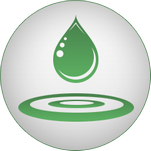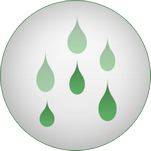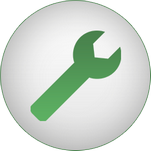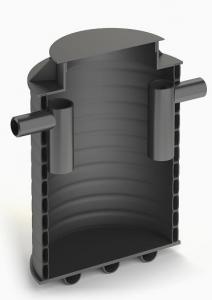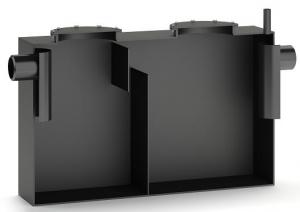Products
Separators, water and waste water management
Coalescence separators are designed for intercepting petroleum substances from wastewater that cannot be allowed into the collecting volume (surface waters, soil, municipal wastewater treatment plant). Such equipment is commonly applied for treatment of rainwater and melting water, coming from contaminated grounds such as industrial areas, ports, airports, cities and towns, roads as well as parking areas and petrol station areas. Such separators may also be used for treatment of process waste water, generated in car depots, manual and automatic car wash stations etc.
A coalescence separator integrated with a sedimentation tank is used for removal of both petroleum substances and mineral suspensions (sand, slurry etc.).
In order to protect the equipment from heavy rainstorms, such separators may be equipped with an internal anti-storm bypass. A compact structure of the equipment facilitates its installation and excludes any requirement to use extensive overflow systems.
All above modifications of a coalescence separator are offered by our company for tanks made of reinforced concrete, polyethylene, and steel. Separators in reinforced concrete tanks are intended for underground installation (vehicle traffic area). Separators in polyethylene and steel tanks are intended for both underground installations as well as stand-alone facilities.
In order to facilitate selection of required product, the equipment have been categorised in the following series of types:
– SEKO – coalescence separator, with flow capacity ranging from 1.5 L/s to 300 L/s, in reinforced concrete tank (SEKO-B), polyethylene tank (SEKO-P) or steel tank (SEKO-EL).
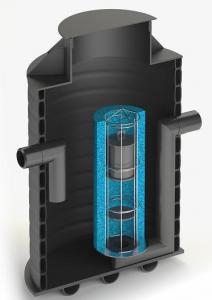
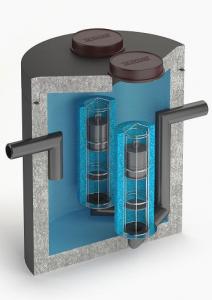
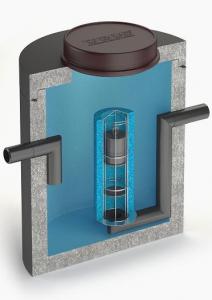
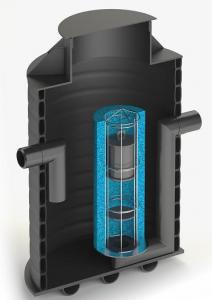
– SEKOT
– SEKOW

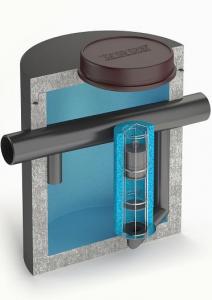

– SEKOTW


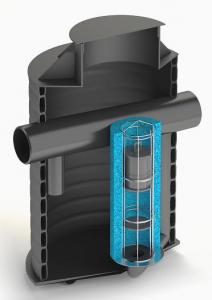
– SEKOT-PSC
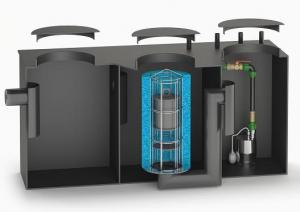
– SEKOT-ELSC

The UGOS company offers both coalescence separators and lamella separators. In order to optimise selection of equipment according to local conditions, the lamella separator may be offered as a vertical cylinder (SEKO type series) or a horizontal cylinder (REKO type series).
Lamella separators are designed for intercepting petroleum substances from wastewater that cannot be allowed into the collecting volume (surface waters, soil, municipal wastewater treatment plant). Such equipment is commonly applied for treatment of rainwater and melting water, coming from contaminated grounds such as industrial areas, ports, airports, cities and towns, roads as well as parking areas and petrol station areas. Such separators may also be used for treatment of process waste water, generated in car depots, manual and automatic car wash stations etc.
A lamella separator integrated with a sedimentation tank is used for removal of both petroleum substances and mineral suspensions (sand, slurry etc.).
In order to protect the equipment from heavy rainstorms, such separators may be equipped with an internal anti-storm bypass. A compact structure of the equipment facilitates its installation and excludes any requirement to use extensive overflow systems.
All above modifications of a coalescence separator are offered by our company for tanks made of reinforced concrete, polyethylene, and steel. Separators in reinforced concrete tanks are intended for underground installation (vehicle traffic area). Separators in polyethylene and steel tanks are intended for both underground installations as well as stand-alone facilities.
In order to facilitate selection of required product, the equipment have been categorised in the following series of types:
– SLEKO – lamella separator, with flow capacity ranging from 1.5 L/s to 300 L/s, in reinforced concrete tank (SLEKO-B) or polyethylene tank (SLEKO-P).
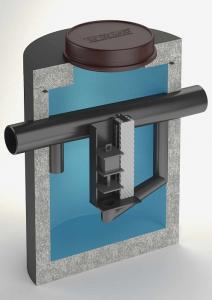
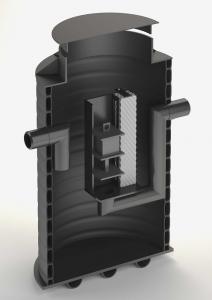
– SLEKOT – lamella separator with a sedimentation tank, with flow capacity ranging from 1.5 L/s to 100 L/s, in reinforced concrete tank (SLEKOT-B) or polyethylene tank (SLEKOT-P).
– SLEKOW – lamella separator with a bypass, with nominal flow capacity ranging from 1.5 L/s to 300 L/s, in reinforced concrete tank (SLEKOW-B) or polyethylene tank (SLEKOW-P).


– SLEKOTW – lamella separator with a bypass and a sedimentation tank, with nominal flow capacity ranging from 1.5 L/s to 100 L/s, in reinforced concrete tank (SLEKOW-B) or polyethylene tank (SLEKOW-P).
– REKO – lamella separator, with flow capacity ranging from 1.5 L/s to 300 L/s, in steel tank (REKO-EL) or polyethylene tank (REKO-P).
– REKOT – REKOT – lamella separator with a sedimentation tank, with flow capacity ranging from 1.5 L/s to 300 L/s, in steel tank (REKOT-EL) or polyethylene tank (REKOT-P).
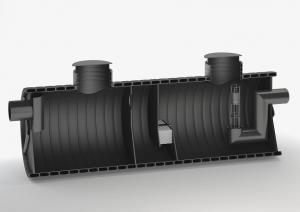
– REKOW – lamella separator with a bypass, with nominal flow capacity ranging from 1.5 L/s to 300 L/s, in steel tank (REKOW-EL) or polyethylene tank (REKOW-P).
– REKOTW – lamella separator with a bypass and a sedimentation tank, with nominal flow capacity ranging from 1.5 L/s to 300 L/s, in steel tank (REKOTW-EL) or polyethylene tank (REKOTW-P).

– RETRAP – mineral suspension sedimentation tank, with active capacity ranging from 150 L up to 17,000 L, in steel tank (RETRAP-EL) or polyethylene tank (RETRAP-P).
Apart from the equipment in the folder, included in the above series of types, we offer customised equipment.
The system is intended for purification of severely contaminated waste water, coming from car wash stations, car depots etc.
It operates under a principles similar to classic biological treatment plant; a major difference is application of specific bacterial flora. The bacterial cultures being used have more efficiency and immunity to toxic substances than conventional bacteria decomposing petroleum substances.
Waste water being generated is directed to a slurry sedimentation tank, in order to separate sand and any impurities, mineralised as a result of bacterial activity. Next, the waste water flows through the upper line to a second tank (and to a third one, if necessary). Water collected from the last tank is saturated with oxygen, using a specialised air supply nozzle. Oxidised waste water is returned to sedimentation tanks, subsequently causing oxidisation of the entire content of the sedimentation tank. As a result of oxidation, there is a dynamic growth of bacterial cultures, feeding on petroleum substances compounds, applied to the system. This biological process is conducted in slurry sedimentation tanks, where products of decomposition of petroleum substances and organic compounds are being sedimented simultaneously. The following step in purification consists in saturation of waste water with air bubbles of 0.2-1.0mm diameter, resulting in flotation of impurities and its return, through the upper overflow line, to slurry sedimentation tanks. Before the fluid being purified is let out of the reactor, it flows through a filter made of stainless steel or plastic.
Purified domestic water is fed, using a suction pump, to be reused in the facility.
Capacity of such systems, depending on demand, may be ranging from 2.0 m3/h to 15.0 m3/h.
FETT equipment is designed for intercepting fat in wastewater that cannot be allowed into the sanitary sewage system. Such equipment is commonly used in any place where excessive amount of fat is generated, such as restaurants, bars, mass catering points and food processing plants.
A fat separator integrated with a sedimentation tank is used for removal of both fat and mineral suspensions (sand, slurry etc.).
Fat separators, which are offered by our company, are being installed in reinforced concrete tanks or polyethylene tanks. Separators in reinforced concrete tanks are intended for underground installation (vehicle traffic area). Separators in polyethylene tanks are intended for both underground installations as well as stand-alone facilities.
In order to facilitate selection of required product, the equipment have been categorised in the following series of types:
– FETT – fat separator, with flow capacity ranging from 1 L/s to 25 L/s, in reinforced concrete tank (FETT-B), polyethylene tank (FETT-P) or steel tank (FETT-EL).
FETT-T – fat separator with a sedimentation tank, with flow capacity ranging from 1 L/s to 25 L/s, in polyethylene tank (FETT-TP) or steel tank (FETT-EL).
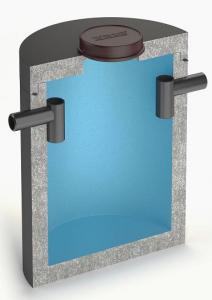

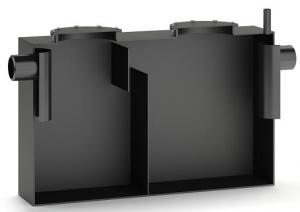
FETT-TPSC – fat separator with a sedimentation tank and a pump chamber, with flow capacity ranging from 1 L/s to 6 L/s, in polyethylene tank
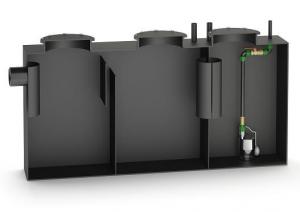
– FETT-TELSC – fat separator with a sedimentation tank and a pump chamber, with flow capacity ranging from 1 L/s to 6 L/s, in steel tank
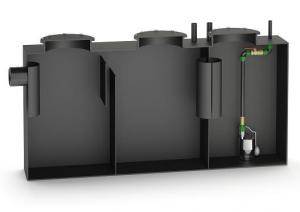
– FETT-TPRS – fat separator with a sedimentation tank, equipped with automated cleaning and emptying system, with flow capacity ranging from 1 L/s to 6 L/s, in polyethylene tank
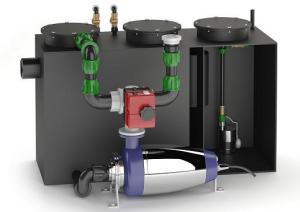
– FETT-TELRS – fat separator with a sedimentation tank, equipped with automated cleaning and emptying system, with flow capacity ranging from 1 L/s to 6 L/s, in steel tank

– FETT-PU – fat separator to be installed under a kitchen sink, with flow capacity ranging from 0.1 L/s to 0.5 L/s, in polyethylene tank
Apart from the equipment in the folder, included in the above series of types, we offer customised equipment.
STH equipment is designed for intercepting starch in wastewater that cannot be allowed into the sanitary sewage system. Such equipment is commonly used in any place where excessive amount of starch is generated, such as restaurants, bars, mass catering points and food processing plants.
A starch separator integrated with a sedimentation tank is used for removal of both fat and mineral suspensions (sand, slurry etc.).
Starch separators, which are offered by our company, are being installed in reinforced concrete tanks or polyethylene tanks. Separators in reinforced concrete tanks are intended for underground installation (vehicle traffic area). Separators in polyethylene tanks are intended for both underground installations as well as stand-alone facilities.
In order to facilitate selection of required product, the equipment have been categorised in the following series of types:
– STH – starch separator, with flow capacity ranging from 1 L/s to 25 L/s, in reinforced concrete tank (STH-B), polyethylene tank (STH-P) or steel tank (STH-EL).
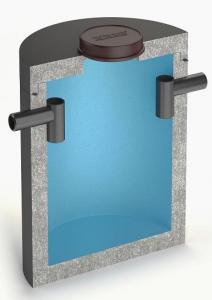


– STH-T – fat separator with a sedimentation tank, with flow capacity ranging from 1 L/s to 25 L/s, in reinforced concrete tank (STH-TB), polyethylene tank (STH-TP) or steel tank (STH-EL).



– STH-TPSC – fat separator with a sedimentation tank and a pump chamber, with flow capacity ranging from 1 L/s to 6 L/s, in polyethylene tank.

– STH-TELSC – fat separator with a sedimentation tank and a pump chamber, with flow capacity ranging from 1 L/s to 6 L/s, in steel tank

Apart from the equipment in the folder, included in the above series of types, we offer customised equipment.
UGOS waste water treatment plant are intended for neutralisation of domestic waste water, generated in households or their small-sized concentrations. Application of UGOS waste water treatment plant is a solution for waste water collection in a place where connection to a collective sewage system is hindered or impossible. Range of the UGOS series of types allows for selection of appropriate equipment for settlements holding from 4 to 500 persons, assuming daily waste water discharge of 150 L per each resident; this results in an efficiency range of 0.6-75 m3/d.
UGOS waste water treatment plant is compact equipment, to be built in a monolithic tank, with technological spaces partitioned within. Tanks of UGOS waste water treatment plant are intended for underground installation. Depending on size of the system, such waste water treatment plant are constructed in polyethylene tanks or reinforced concrete tanks. Each piece of equipment in the type series may differ by size and construction details, however, the principle of operation of such equipment is the same.
Waste water, being let in such equipment, is subject to mechanical and biological purification (active sedimentation technology). Waste water treatment is conducted through the subsequent processes of sedimentation, denitrification, dephosphatation, and filtration. As a result, an ecological effect is being achieved, complying with the requirements of the Regulation of the Minister of Environment of the 24th of July, 2006 (Journal of Laws No. 137, item 984) concerning conditions to be met while introducing waste water to waters or ground and concerning substances specifically harmful to aquatic environment:
| Contamination index | Maximum contamination concentration in purified waste water [g/m3] |
General suspension | 50 |
BOD 5 | 30 |
COD | 150 |
Total nitrogen | 30 |
Total phosphorus | 5 |
Apart from high technological capacity, another advantage of UGOS waste water treatment plant is limitation to basic operational activities. Treatment plant operation is limited to monthly intervention, comprising of: excessive sedimentation level check, discharge filter cleaning, and blower filter cleaning. Additionally, it is required to remove any excessive sedimentation periodically; the intervals between subsequent interventions of that kind depend on the biomass growth rate.
Capacity of UGOS treatment plant may be ranging from 2.0 m3/h to 15.0 m3/h (operation from 4 to 500 PE (population equivalent).
The UGOS company offers acid neutralisers in polyethylene housing.
NTK equipment is intended for neutralisation of acids, appearing in waste water. Such equipment may be used in the initial section of sewage system in places with higher risk of such system being infiltrated by acids, e.g. laboratories, chemical workshops, battery operation plants, storage facilities equipped with battery-driven fork trucks etc.
NTK neutralisers, which are offered by our company, are being installed in polyethylene tanks. Such equipment is intended for both underground installations and stand-alone facilities.
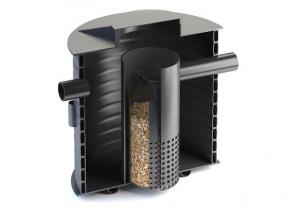
Anti-flood valves are devices intended for containing any flooding, to be installed in vertical lines. FK equipment prevents any reverse flow of waste water in a sewage system. Anti-flood valves may be applied e.g. in sewage system outlets, in troughs with high fluctuation of fluid level (natural water courses, drainage ditches).
FK anti-flood valves are made of polyethylene. Due to high differentiation of potential installation points, we offer end point valves and network valves. Considering different ways for connecting anti-flood valve with a sewage system, we manufacture anti-flood valves with bare connector or flange connector.
In order to facilitate selection of required product, the equipment have been categorised in the following series of types:
– FK-LB – bare end point anti-flood valve
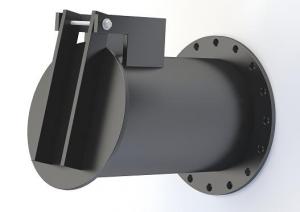
– FK-LK – flange end point anti-flood valve

– FK-SB – bare network anti-flood valve
– FK-SK – flange network anti-flood valve
Flow regulators are to be used in rainwater sewage system and technological sewage system, where high flow fluctuation occurs. In cooperation with retention tanks (or retention wells), a flow regulator causes alignment of flow wave by limiting maximum flow capacity. Application of a flow regulator protects other equipment, built upon a sewage system, from hydraulic overload which could cause ineffective operation or even damage. Installing such regulator also enables adjustment of momentary flow to values indicated in a water law permit.
Such flow regulator is made of plastic, PE-HD (non-corrosive material) or stainless steel. A flow regulator structure depends on assumed flow discharge downstream and hydrostatic pressure resulting from maximum fluid level in a tank where such equipment has been installed. The equipment inlet is protected from any impurities with a size constituting a risk of causing incorrect operation of a suppressing system. The flow regulator’s structure enables its stable attachment to the ground of a retention well/tank.
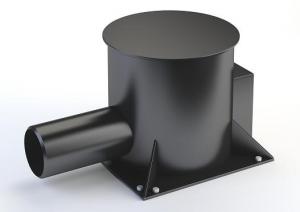
We offer tanks made of:
- concrete
- PEHD
- glass fibre-reinforced polyester (GRP) laminate
- steel

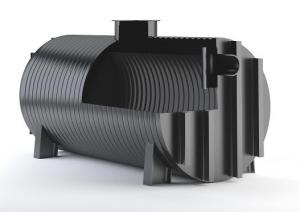
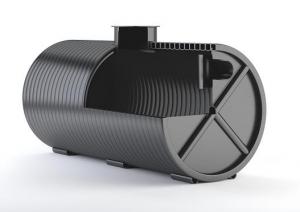
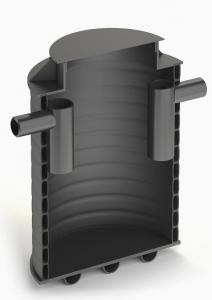
The UGOS company offers storage tanks up to 1200m3 capacity.
Such tanks may be used as:
– potable water tanks
– fire water tanks
– retention tanks
– waste water tanks
Such tanks are offered in a number of options, with regard to their material:
– C35/45 concrete
– PE-HD – high-density polyethylene
– steel
– GRP laminate
CONCRETE TANKS
Tanks made of concrete prefabricates. All components are manufactured of C35/45 concrete (or C45/55, if customised order) with high W8 tightness class and F150 frost resistance class. These tanks comply with requirements of PN-B 3264:2002, PN-EN 1917, PN-EN 206-1, and PN-B 10702:1999. Installation is included in our offer. We use top quality finishing materials, thus assuring top tightness of the tank.
Our tanks are offered in two variants:
MODULAR TANKS
Made of reinforced concrete prefabricates with diameters of Ø5000 and Ø6000. Introduction of an extension component allows for future enhancement of such tank. This tank is offered with different height options, with a possibility to use a superstructure.
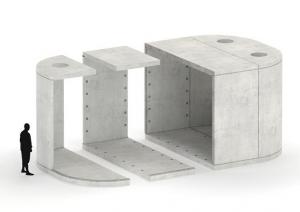
SHELL TANKS
Made as a system of joint reinforced concrete components. It enables enhancement of a tank up to a capacity of 1200m3, over a previously prepared foundation slab. Shell tanks comply with requirements related to water collection, pre-purifying and retention. Shell tanks may installed as underground tanks, partially recessed tanks or ground-based tanks with the following diameters: 5m, 6m, 8m, 10.5m, 14m, 15m, 15.5m, and 16m.
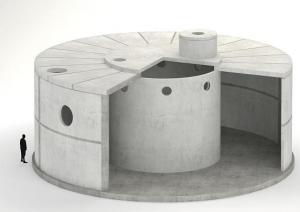
TANKS MADE OF PE-HD, STEEL OR GRP
These tanks are manufactured as cylinders, with horizontal or vertical axis. Their endurance is adjusted to local siting conditions. It is possible to join tanks, forming larger units, in order to enhance their active capacity. Each tank may be separately armed with required fixtures and fittings.
SEWER INSPECTION CHAMBERS
Out of materials that are used for storage tanks, we also manufacture sewer inspection chambers. In any case, we are able to adjust our work to height requirements, to equip the chamber with suitable number of connectors (terminals, watertight passages), and to profile the bottom in appropriate manner.


The UGOS company offers drainage chambers.
Purpose:
The drainage chambers are pieces of equipment designed for water drainage for urbanised areas. The chamber system may be installed in road areas as well as in green areas. The drainage chambers are commonly used in places where introduction of additional amount of rainwater to municipal sewage system is hindered, costly or downright impossible. A drainage chamber system may be an alternative for traditional retention tanks, absorbing wells, pipe infiltration drains etc.
System advantages:
– unlimited system capacity;
– easy, quick and safe installation;
– possibility to enhance or transfer;
– very high strength (14.5T/axis) – which means a fully-loaded heavy goods vehicle;
– high patency;
– possibility of inspection (e.g. with a camera) and pressure-cleaning.
Innovative and flexible system for rainwater management
Urbanisation processes, spreading of urban areas, development of technical infrastructure are the reasons more and more ground surface is covered with non-permeable layers, e.g. asphalt, concrete etc. This poses a challenge to be faced: resolving such problems as excessive amounts of rainwater, sewage system overload, and lowering of groundwater level.
In order to limit such phenomena, negatively affecting natural environment, it is vital to reasonably manage any rainwater.
Infiltration boxes are intended for draining any hardened surfaces such as parking areas, squares, rooftops and green areas. Structure of an infiltration box, comprising a 500mm inspection tunnel, enables monitoring and cleaning of the interior of the underground system. Its distinctive feature is also exceptionally easy installation of modules that, even in large-scale projects, may be completed by few persons.
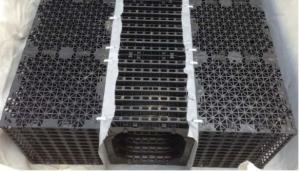
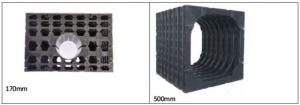
The UGOS company offers hatches and inlets made of ductile iron or grey cast, with load class ranging from A 15 to F 900. Such components are used for communication surfaces in pedestrian and vehicle traffic, i.e. roads, sidewalks, airports etc. The aforementioned hatches are also offered with iron cast lid or with concrete filling.
TRAP equipment is designed for intercepting mineral suspension in wastewater that cannot be allowed into the collecting volume (surface waters, soil, municipal wastewater treatment plant). Such equipment is commonly applied for treatment of rainwater and melting water, coming from contaminated grounds such as industrial areas, ports, airports, cities and towns, roads etc.
Sedimentation tanks, which are offered by our company, are being installed in reinforced concrete tanks, polyethylene tanks or steel tanks. Sedimentation tanks in reinforced concrete tanks are intended for underground installation (vehicle traffic area). Such pieces of equipment in polyethylene and steel tanks are intended for both underground installations as well as stand-alone facilities.
In order to facilitate selection of required product, the equipment have been categorised in the following series of types:
– TRAP-P – Mineral suspension sedimentation tanks, in polyethylene tank

– TRAP-B – Mineral suspension sedimentation tanks, in reinforced concrete tank

– TRAP-EL – Mineral suspension sedimentation tanks, in steel tank
Apart from the equipment in the folder, included in the above series of types, we offer customised equipment.
UGOS Ochrona Środowiska offers alarm systems for coalescing clarifiers, fat clarifiers, slurry sedimentation tanks, and retention tanks.
The alarm system consists of acoustic and visual indicator, with connected sensors. An indicator has been designed for operation in ambient temperature ranging from -15°C to +40°C. Sensors operate in an environment with ambient temperature ranging from -20°C to +60°C. The following sensors are available:
– fluid level sensor;
– oil/petrol/fat layer thickness sensor;
– sedimentation layer thickness sensor;
All pieces of equipment have been designed with intrinsically safe electrical circuits.
We offer construction of tanks intended for surface galvanisation processes. Such baths are made in strict compliance with the customer’s guidelines. For bath manufacturing, we use polyethylene or polypropylene, which have longer product life and more competitive price in comparison to traditional materials (steel, stainless steel).
Employing our vast experience in the field of polyethylene processing, we are able to offer a number of customised components, to be manufactured according to specific design. Based on our experience, we are able to manufacture insulation/repair inserts for concrete tanks, troughs, containers, and any other polyethylene structures.
Water and waste water pump facilities Monitoring
Sanitary waste water pump facilities are challenged, due to onerous medium, with exceptionally high requirements. Our tried and tested technologies, particularly analysis and selection of pumps from renowned manufacturers, ensure long-lasting and faultless operation, minimum risk of rotor clogging, and optimum time of waste water retentioning. Short time of waste water retention prevents fouling and generation of odour nuisances. Additionally, our pump facilities are equipped with technological slants, reducing dead retention, and active carbon filters. For the most demanding customers, we may propose fully automated anti-odour agent dosing systems, integrated with pump facility operation algorithm.
Rainwater and drainage pump facilities, other than sanitary water pump facilities, are much less exposed to damage or rotor clogging by any solids contained in waste water. In an attempt to meet our customers’ expectations with regard to selection and optimisation of rainwater pump facilities, we strive to minimise costs of investment and subsequent operation. To this end, we choose the most cost-effective pumps possible, and adjust pipework and fixtures so that the pump duty point lies in their best efficiency point.
It is required to pay special attention to pump facilities cooperating with retention tanks and/or flow regulators. Our customers are provided with professional advice and pump selection so that, notwithstanding the retention tank fill level, pumps operate faultlessly, without any risk of overload or cavitation.
Due to much varied characteristic of technological waste water, both in terms of chemical and physical properties, technological pump facilities constitute a serious challenge for our technical department. Heat, low and high pH, large amounts of chlorine or any other oxidizers, high percentage of dry mass content, abrasive properties – this is only a selection of issues to be faced by our experts. Using our vast knowledge, experience, and technological capabilities we can offer equipment adjusted to our customers’ needs.
Due to a requirement to provide low dimensions and low cost for the investment, domestic pump facilities are most frequently single-pump systems, based on a single pump with a macerator pump and simplified automation (with all essential safeguards preserved). We offer pump facilities to be constructed in PEHD tanks and C35/45 concrete tanks, with possibility to customise the tank height. Our offer also contains compact low-sized pump facilities for draining driveways, ramps etc.
We offer ready-for-use pressure booster facilities of renowned manufacturers, designed with water supply and fire suppression in mind, equipped with advanced automation with an option to transfer data to and from BMS (Building Management System). Upon any customer’s request, we may perform start-up and operational check of any offered system.
Due to large amounts of solid waste, including long and fibrous waste (rags, strings, nappies, bandages), contained in sanitary waste water, pumps are put under a severe risk of clogging. Large clearances between pump rotor blades prevent clogging, but, unfortunately, significantly reduce pump capacity. Compression stations, due to application of solid waste separators, allow for installation of high capacity aggregates. Energy-effectiveness is not the only advantage of such equipment. Solid waste separators minimise failure risk and extend life cycle of pumps and fixtures and fittings.
Operation and maintenance of the equipment is facilitated as well, due to dry setting of the pumps. Control cabinets, supplied by UGOS Ochrona Środowiska, ensure automated operation and control of a compression system as well as its diagnostics in case of failure. Each cabinet contains a complete set of safeguards, programmable controller with a display, a set of lamps for visualisation of pump facility states and diagnostics, a manual mode, simulation of minimum level allowing pumping waste water down to the lowest safe level, an acoustic and visual alarm (an option to turn sound off is available). A control cabinet may be expanded with a number of additional components, if necessary, such as aggregate socket, electric power measurement, alarm system (anti-burglary system), voltage sustenance system, additional pump safety measures (e.g. humidity sensor), internal lighting, dusk sensor for control of external lighting, rain sensor or flowmeter converter. Waste water level measurement in a pump facility is conducted using a set of floaters or a hydrostatic probe and two safety floaters (these may be used to control the pump facility if the probe fails).
Notwithstanding selected configuration of a control cabinet, each cabinet may be equipped with a remote communication system, used for alerting any failures. Programmed messages are sent through mobile phone network to a provided phone number of a service team or output for visualisation in the BMS (Building Management System) through potential-free contacts. BMS may also receive analogue signals, such as waste water level read by a hydrostatic probe or current intensity in the pump input.
For our most demanding customers, we offer monitoring and remote control of a pump facility, operated by means of GPRS modem, together with installation of a base station, and delivery of software and visualisation. We also manufacture control stations adjusted to existing monitoring systems, according to diagrams and information provided by a user of a system already being operated.
Industrial waste water treatment plants
Industrial waste water treatment
TO BE APPLIED IN THE FOLLOWING FIELDS | CONTAMINATION REDUCTIONS |
– MANUFACTURING PAINTS AND PLASTERS | – HIGH CONCENTRATIONS OF GENERAL SUSPENSION |
– MANUFACTURING PACKAGING; PRINTING FACILITIES | – COD, FAT, OILS, DETERGENTS |
– GLASS AND METAL MACHINING | – HEAVY METALS |
– OTHER INDUSTRIAL WASTE WATER | – NEUTRALISED PH |
PROCESS DESCRIPTION
Waste water generated in a manufacturing plant is collected in a buffer tank, in order to average it in terms of quantity and quality. Such tank may be a concrete tank, to be installed underground (allowing for traffic above / in the green area) or a ground-based PE/PP tank, to be installed in a hall. Such buffer tank is equipped with a mixer and level gauges. Upon reaching set fill level, automation system turns on purification process. Waste water is automatically fed to UGOS TECH-SED equipment where chemical precipitation takes place. As a result of dosing coagulants, pH correction agents and flocculants, any contamination is precipitated and subsequently sedimented, forming a sediment at the bottom. The entire process is controlled via control cabinet. The final stage of purification consists of dehydration of sediment in a chamber filter press and subsequent discharge of purified waste water to the sewage system.
UGOS TECH-SED equipment structure
– high quality framework made of steel and plastic;
– to be constructed in a hall or as a modular structure outdoors (insulated, ventilated, and heated containers);
– pipework made of plastic: PE, PVC.
UGOS TECH-SED equipment properties
– standard capacity ranging from 1000 to 5000 L/h (larger capacity upon customer’s request);
– modular structure and low space demand;
– operation technology adjusted for medium- and highly-contaminated waste water;
– optimum pH correction for the process and discharge to the sewage system;
– the lowest possible costs of operation, achieved by dosing liquid chemical agents.
UGOS TECH-SED equipment controls
– the entire process of waste water purification is controlled;
– fully-automated and visualised system;
– gauging with indication of chemical agent exhaustion;
UGOS TECH-SED offer range
– delivery and furnishing of a buffer tank;
– pipework, fixtures and fittings, and feeding pumps;
-a reactor with pH neutralisation system and process chemicals dosage system;
– sediment dehydration system;
– control cabinet with full automation.
Optionally
– GSM communication from a controller, notifying of any event;
– gauging tank fill level, using a hydrostatic pump;
– additional chemicals dosage;
– adjusted sediment dehydration system.
Type series
Device type | Capacity [m3/d] | Tank capacity [m3] | Space demand [m2] |
UGOS TECH-SED 5 | 5 | 5 | ca. 20 |
UGOS TECH-SED 10 | 10 | 10 | ca. 25 |
UGOS TECH-SED 20 | 20 | 19 | ca. 30 |
UGOS TECH-SED 50 | 50 | 19 | ca. 50 |
Technological tests and analyses
– to verify correct selection of equipment and process agents.
Industrial waste water treatment with water recovery
TO BE APPLIED IN THE FOLLOWING FIELDS | CONTAMINATION REDUCTIONS |
– MANUFACTURING PAINTS AND PLASTERS | – HIGH CONCENTRATIONS OF GENERAL SUSPENSION |
– MANUFACTURING PACKAGING; PRINTING FACILITIES | – COD, FAT, OILS, DETERGENTS |
– GLASS AND METAL MACHINING | – HEAVY METALS |
– OTHER INDUSTRIAL WASTE WATER | – NEUTRALISED PH |
PROCESS DESCRIPTION
Waste water generated in a manufacturing plant is collected in a buffer tank, in order to average it in terms of quantity and quality. Such tank may be a concrete tank, to be installed underground (allowing for traffic above / in the green area) or a ground-based PE/PP tank, to be installed in a hall. Such buffer tank is equipped with a mixer and level gauges. Upon reaching set fill level, automation system turns on purification process. Waste water is automatically fed to UGOS TECH-NEUTRAL equipment where chemical precipitation takes place. As a result of dosing coagulants, pH correction agents and flocculants, any contamination is precipitated and subsequently sedimented, forming a sediment at the bottom. The entire process is controlled via control cabinet. The final stage of purification consists of dehydration of sediment and subsequent discharge of water to a process water tank or to the sewage system.
UGOS TECH-NEUTRAL equipment structure
– high quality framework made of steel and plastic;
– to be constructed in a hall or as a modular structure outdoors (insulated, ventilated, and heated containers);
– pipework made of plastic: PE, PVC.
UGOS TECH-NEUTRAL equipment properties
– standard capacity ranging from 500 to 1000 L/h (larger capacity upon customer’s request);
– modular structure and low space demand;
– operation technology adjusted for medium- and highly-contaminated waste water;
– optimum pH correction for the process and discharge to the sewage system;
– the lowest possible costs of operation, achieved by dosing liquid chemical agents.
UGOS TECH-NEUTRAL equipment controls
– the entire process of waste water purification is controlled;
– fully-automated and visualised system;
– automated pH measurement and correction.
UGOS TECH-NEUTRAL offer range
– delivery and furnishing of a buffer tank;
– pipework, fixtures and fittings, and feeding pumps;
-a reactor with pH neutralisation system and process chemicals dosage system;
– sediment dehydration filter system;
– process water tank with accessories;
– control cabinet with full automation.
Optionally
– GSM communication with a controller, for notification of any event;
– gauging tank fill level, using a hydrostatic pump;
– additional chemicals dosage;
– adjusted sediment dehydration system.
Type series
Device type | Capacity [m3/d] | Waste water tank capacity [m3] | Process water tank capacity [m3] | Space demand [m2] |
UGOS TECH-NEUTRAL 1 | 1 | 2 | 2 | ca. 25 |
UGOS TECH-NEUTRAL 3 | 3 | 3 | 4 | ca. 30 |
UGOS TECH-NEUTRAL 5 | 5 | 4 | ok. 35 | |
UGOS TECH-NEUTRAL 10 | 10 | 10 | 8 | ca. 50 |
Technological tests and analyses
– to verify correct selection of equipment and process agents.
Industrial waste water treatment by pressure flotation method
TO BE APPLIED IN THE FOLLOWING FIELDS | CONTAMINATION REDUCTIONS |
– CHEMICAL PRODUCTION | – MEDIUM CONCENTRATION OF SUSPENSION |
– STORAGE TANK INTERIOR WASHING | – COD, BOD, FAT, OILS, DETERGENTS |
– FOOD PRODUCTION | – HEAVY METALS |
– OTHER INDUSTRIAL WASTE WATER | – NEUTRALISED PH |
PROCESS DESCRIPTION
Waste water from a manufacturing plant is fed to a pump facility, and subsequently fed to a drum sieve. A sieve with 0.5-1.00mm mesh size ensures removal of any large-size impurities from waste water. Subsequently, waste water is collected in a mixed buffer tank, in order to average it in terms of quantity and quality. Such tank may be a concrete tank, to be installed underground (allowing for traffic above / in the green area) or a ground-based PE/PP tank, to be installed in a hall. Such buffer tank is equipped with a mixer and level gauges. Upon reaching set fill level, automation system turns on purification process. Waste water is automatically fed to UGOS TECH-FLO equipment; first, chemical precipitation takes place in pipe flocculator. As a result of dosing coagulants, pH correction agents and flocculants, any contamination is precipitated. Subsequently, waste water is fed to a flotation tank where sediment is being separated from purified waste water through flotation process. The entire process is controlled via control cabinet. The final stage of purification consists of pumping down sediment and subsequent discharge of purified waste water to the sewage system.
UGOS TECH-FLO equipment structure
– high quality framework made of steel and plastic;
– to be constructed in a hall or as a modular structure outdoors (insulated, ventilated, and heated containers);
– pipework made of plastic: PE, PVC.
UGOS TECH-FLO equipment properties
– standard capacity ranging from 1 to 500 L/h (larger capacity upon customer’s request);
– modular structure and low space demand;
– operation technology adjusted for medium- and highly-contaminated waste water;
– optimum pH correction for the process and discharge to the sewage system;
– the lowest possible operational costs, due to automation and selection of chemical agents.
UGOS TECH-FLO equipment controls
– the entire process of waste water purification is controlled;
– fully-automated and visualised system;
– automated pH measurement and correction.
UGOS TECH-FLO offer range
– delivery and furnishing of a pump facility;
– a drum sieve;
– delivery and furnishing of a buffer tank;
– feeding pumps;
– a flocculator and a flotation tank with process chemicals dosing systems;
– automation and control system.
Optionally
– sediment dehydration system;
– GSM communication from a controller, notifying of any event;
– additional chemicals dosage;
Type series
Device type | Capacity [m3/h] | Waste water tank capacity [m3] | Space demand [m2] |
UGOS TECH-FLO 2 | 2 | 10 | ca. 25 |
UGOS TECH-FLO 5 | 5 | 20 | ca. 30 |
UGOS TECH-FLO 10 | 10 | 50 | ca. 60 |
UGOS TECH-FLO 20 | 20 | 100 | ca. 90 |
UGOS TECH-FLO 50 | 50 | 200 | ca. 150 |
Technological tests and analyses
– to verify correct selection of equipment and process agents.
Grey water treatment
TO BE APPLIED IN CIVIL ENGINEERING |
| |
– RESIDENTIAL SINGLE-FAMILY/MULTI-FAMILY BUILDINGS | – BOD5 (ALSO DESIGNATED WITH BOD7) | |
– HOTELS AND OFFICE BUILDINGS | – E. COLI BACTERIA | |
– AQUAPARKS | – GENERAL SUSPENSION | |
– PUBLIC BUILDINGS | – OXYGEN SATURATION > 50% |
PROCESS DESCRIPTION
Grey water coming from wash-basins, showers, baths, washing machines, and pre-purified kitchen waste water is fed through a separate grey water sewage system to the UGOS TECH-SZARAWODA equipment.
At the equipment’s inlet, there has to be a large-size solid filter, adjusted to local facility conditions. Subsequently, grey water is fed to process chambers where, first in pre-processing chamber, and then in filter chamber, it is subject to biological purification process. During the next stage, in order to separate sediment and remove any other contamination, grey water is filtered in filtration modules. Purified grey water is fed to a process water tank from where it is distributed for toilet flushing, green area irrigation or any other purpose which do not require potable water quality level.
Purified grey water may be used alone or mixed with rainwater in any civil engineering object.
UGOS TECH-SZARAWODA equipment structure
– high quality framework made of concrete or plastic;
– pipework made of plastic: PE, PVC.
UGOS TECH-SZARAWODA equipment properties
– standard capacity ranging from 1 to 15 m3/d (larger capacity upon customer’s request);
– modular structure and low space demand;
– operation technology adjusted for grey water and pre-purified kitchen waste water;
UGOS TECH-SZARAWODA equipment controls
– the entire process of grey water purification is controlled, with an option to connect to the BMS.
UGOS TECH-SZARAWODA offer range
– delivery and furnishing of tanks;
– feeding pumps, a reactor with a filter system, and controls.
Optionally
– GSM communication from a controller, notifying of any event;
– grey water disinfection by means of a UV lamp and suitable chemical agents.
Type series
Equipment type | Capacity [m3/d] | Grey water tank capacity [m3] | Space demand [m2] |
UGOS TECH-SZARAWODA 2 | 2 | 2 | ca. 10 |
UGOS TECH-SZARAWODA 5 | 5 | 5 | ca. 15 |
UGOS TECH-SZARAWODA 7 | 7 | 7 | ca. 15 |
UGOS TECH-SZARAWODA 10 | 10 | 10 | ca. 20 |
UGOS TECH-SZARAWODA 15 | 15 | 15 | ca. 20 |
Technological tests and analyses
– to verify correct selection of equipment and process agents.
Biological treatment of waste water
TO BE APPLIED IN SMALL-SCALE PLANTS | CONTAMINATION REDUCTIONS |
– FOOD PRODUCTION | – COD |
– CHEMICAL PRODUCTION | – BOD5 |
– PURIFICATION OF WASTE WATER WITH SOLUBLE SUBSTANCES | – NITROGEN (N) COMPOUNDS |
– OTHER INDUSTRIAL APPLICATIONS | – PHOSPHORUS (P) COMPOUNDS |
Biological treatment of waste water is used in industrial plants at any lines discharging purified waste water to natural environment as well as industrial plants connected to the sewage system where waste water disposal conditions require to remove any dissolved contamination which is unable to be removed via chemical pre-purification, using UGOS TECH-SED and UGOS TECH-FLO technologies. A condition for application of biological treatment system for industrial waste water is pre-purification of waste water with a sieve, its appropriate buffering, and possible application of physical and chemical pre-purification methods for the purpose of removal of excessive suspension, fat, detergents or heavy metals. During such biological treatment process, any impurities are removed by means of active sediment technology in which suitable conditions of aeration of waste water enable conducting processes with minimised costs. The entire process is controlled via control cabinet. The final stage of purification consists of pumping down excessive sediment and subsequent discharge of purified waste water to the sewage system or natural environment.
UGOS TECH-BIO equipment structure
– high quality framework made of concrete and plastic;
– to be constructed in a hall or as a modular structure outdoors;
– pipework made of plastic: PE, PVC.
UGOS TECH-BIO equipment properties
– standard capacity ranging from 1 to 60 m3/d (larger capacity upon customer’s request);
– modular structure and low space demand;
– technology adjusted for pre-purified biodegradable industrial waste water;
– the lowest possible costs of operation.
UGOS TECH-BIO equipment controls
– the entire process of waste water purification is controlled;
– fully-automated and visualised system;
UGOS TECH-BIO offer range
– delivery and furnishing of concrete components;
– feeding pumps;
– a blower and an aeration system;
– a sediment dehydration system with a pump;
– controls supplemented with automation system.
Optionally
– GSM communication with a controller, for notification of any event;
– gauging tank fill level, using a hydrostatic pump;
– additional chemicals dosage;
Type series
Device type | Capacity [L/h] | Total tank capacity [m3] | COD load [kg/d] | Ground-based structure area[m2] |
UGOS TECH-BIO 10 | 500 | ca. 40 | 20 | ca. 10 |
UGOS TECH-BIO 20 | 1000 | ca. 80 | 40 | ca. 15 |
UGOS TECH-BIO 40 | 2000 | ca. 120 | 80 | ca. 20 |
UGOS TECH-BIO 60 | 3000 | ca. 200 | 120 | ca. 40 |
Technological tests and analyses
– to verify correct selection of equipment and process agents.
Technical service, cleaning and emptying
The UGOS company renders services consisting in removing gathered waste from clarifiers and sedimentation tanks and cleaning such equipment country-wide. It is possible due to a tank truck fleet and professional, experienced, and appropriately trained personnel.
Any sediment waste (slurry, sand) and liquid waste (water and oil mixture, fat), collected at the site of service provision, is transported and transferred to Neutralisation Facilities, according to the environment protection regulations.
Properly equipped trucks and qualified employees ensure top professionalism of our services. Each service is of utmost importance to us, hence we strive to perform our duties professionally and in a manner that is safe for natural environment.
At the same time we would like you to notice that, according to applicable regulations – Regulation of the Minister of Environment of the 24th of July, 2014 concerning conditions to be met while introducing waste water to waters or ground and concerning substances specifically harmful to aquatic environment Art. 23 Section 1: Compliance with the terms referred to in Art. 21. Section 1 It is evaluated according to operational reviews of purification equipment, to be performed by a company at least biannually. Operation of such equipment should comply with recommendations contained in the equipment operation and maintenance manual – it is recommended to perform periodical review at least 2 times a year, and to empty the equipment at least once a year.
With regard to fat clarifiers, it is required to remove gathered impurities twice per month (not less frequently than once a month – according to PN-EN 1825-2) – and to perform general cleaning not less frequently than once every 3 months.
The sewage system cleaning is performed due to periodical requirement to remove accumulating sediments from any pipes and tubes. Accumulation of sediments is mostly caused by improper waste composition (e.g. pouring mineral suspensions to the sewer system or flushing down edible fat – no clarifier) or too low amount of liquid waste. Sometimes, it is required due to insufficient longitudinal slope in the sewage system section which prevents such line from self-cleaning.
Also, waste water pump facilities require periodical emptying as the pumps are incapable of transferring any accumulated sediments, fat, and other solid waste which should not get into the sewage system in the first place.
Regulation of the Minister of Environment of the 24th of July, 2014 concerning conditions to be met while introducing waste water to waters or ground and concerning substances specifically harmful to aquatic environment Art. 23 Section 1 requires compliance with the terms referred to in Art. 21. Section 1) by evaluation according to operational reviews of purification equipment, to be performed by a company at least biannually. Our knowledge, gained experience and appropriate technical background and personnel enable us to provide maintenance services of the highest quality.
Our services include the following:
– periodical technical reviews of clarifiers;
– technical reviews of rainwater and sanitary waste water pump facilities;
– technical reviews, warranty and post-warranty repairs for any equipment manufactured by UGOS Ochrona Środowiska (exclusive authorised technical maintenance).
Each maintenance service, performed by our company, shall be confirmed by an appropriate report and an entry in the equipment’s operation log. Thus, you obtain all documents required to be shown to appropriate inspection authorities.
A sensible link in our business is a set of services concerning installation or replacement of obsolete equipment with brand new equipment, manufactured by UGOS. A very important issue is related to correct start-up of clarifiers in consequence of their installation by any third party; we are able to offer such service as a part of an initial/start-up technical review.
A frequent cause of incorrect operation of a clarifier is its improper start-up. Therefore, it may be a good choice to have such operation be performed by professional and experienced employees, with excellent knowledge of the structure and the principle of operation of such equipment. If you feel any anxiety in relation to your brand new clarifier, contact us please.
In particular, we invite you to establish regular cooperation with our company, concerning technical maintenance of waste water treatment equipment (particularly clarifiers and pumping facilities). It has been proven in practice that owners of equipment in question tend to forget about the requirement to perform maintenance which far too many times resulted in flooding of a facility or other problems. In an attempt to prevent such unpleasant events, we encourage you to enter into a “rolling maintenance service contract” for your equipment, which may also prove cost-effective, in comparison to maintenance performed under separate contracts.
Entering into a rolling service contract for your UGOS equipment may result in extending your warranty for this equipment by up to 3 years.

